Retrospective: Seymour Eaton's 'The Roosevelt Bears'
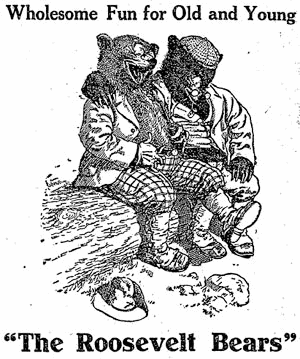 From 1905 for about the next twenty years, Seymour Eaton's anthropomorphic bears were the subject of some of the most popular children’s books in America. Their topical popularity was due to the tie-in between the bears and Teddy Roosevelt during the 1900s when TR was President of the U.S., and the 1910s when there was widespread speculation whether he would try to run for a third term.
From 1905 for about the next twenty years, Seymour Eaton's anthropomorphic bears were the subject of some of the most popular children’s books in America. Their topical popularity was due to the tie-in between the bears and Teddy Roosevelt during the 1900s when TR was President of the U.S., and the 1910s when there was widespread speculation whether he would try to run for a third term.
But Eaton died in 1916 and Roosevelt died just two months after World War I ended. The publisher tried to keep the series alive with reprints in 1921, but by the Roaring ‘20s American pop culture had moved on, and TR and the Roosevelt Bears became quickly passé.
Seymour Eaton (1859-1916) was primarily an author of educational manuals and textbooks, such as Business Forms, Customs and Accounts, for Schools and Colleges (1894) and How to Prepare for a Civil Service Examination (1897). He wrote one short novel for adults, Dan Black: Editor and Proprietor: a Story (Philadelphia, The Library Publishing Company, 1903, 54 p.)
Meanwhile, in 1902 President Roosevelt went on a well-publicized hunting trip in the South. His staff thought that they were being helpful by capturing a young bear and tying it to a tree for Teddy to easily shoot. Roosevelt refused such an unsportsmanlike shot and ordered the bear released. The story was thoroughly covered throughout America; it was notably featured in political cartoonist Clifford Berryman’s “Drawing the Line in Mississippi” sketch, and the Teddy Bear craze was born.
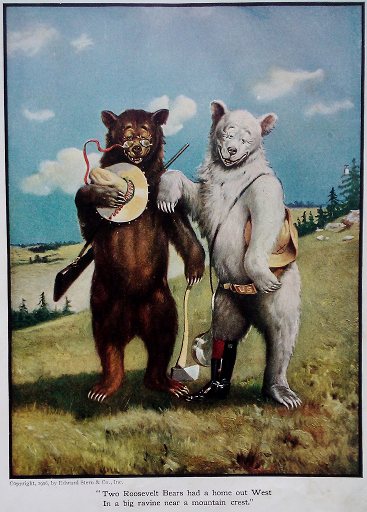
In 1905 Eaton got the idea of writing a humorous weekly newspaper serialized poetry feature for children, starring two friendly anthropomorphized full-sized bears who came from the wilds of Colorado to explore human civilization. The bears took the names of Teddy-B and Teddy-G (one was black or brown and the other was gray) from favorable coverage of Teddy Roosevelt in newspapers and other litter left by hunters:
The “Teddy” part is a name they found
On hat and tree and leggings round,
On belt and boot, and plates of tin,
And scraps of paper and biscuits thin,
And other things that hunters drop
When they chase a bear to a mountain top.
I would like to thank Charles Moose for pointing out that the name "teddy bears" did not exist before Eaton's Roosevelt Bears newspaper feature. The popular plush bear toys certainly did, but they were not called "teddy" bears before Eaton popularized the Roosevelt Bears name. At first Eaton did not want to risk damaging his reputation as a serious writer of educational books, so he wrote his children’s serial under the pseudonym of Paul Piper. His early pages and first book were illustrated with humorous drawings by V. Floyd Campbell. When Campbell died in 1906, other artists copied his style.
In the late 1800s and early 1900s it was common for newspapers to include a section for children. Most of these were either short educational features or a serialized and illustrated children’s story — and most were soon forgotten, but a few were collected and reprinted as books. The most famous example is probably the Italian The Adventures of Pinocchio, by Carlo Collodi, serialized in Il Giornale dei Bambini (1881–83).
In America, the first and most popular example was The Brownies, written in verse and illustrated by Palmer Cox from 1883 in such magazines as St. Nicholas Magazine and Ladies’ Home Journal, and as a newspaper Sunday page starting in 1903; and collected into books starting with The Brownies, Their Book (New York, The Century Company, 1887, 144 pages) and fifteen more through 1918. The Brownies were the first children’s feature to be commercially merchandized, appearing in two popular stage plays and many products such as dolls, soap, table clothes, chinaware, biscuits, and sheet music; notably the Kodak Brownie camera. They did so well for Cox that he built a seventeen-room, turreted Scottish-style estate called Brownie Castle in his home town of Granby, Quebec, with Brownies on its flags, weathervanes, and a stained-glass window; and his tombstone features a Brownie. Eaton probably hoped to duplicate The Brownies’s success. But none of these children’s illustrated text serials were comic strips; therefore they are not mentioned in modern popular histories of the development of comic strips. Eaton’s The Roosevelt Bears is forgotten today, except by arctophiles – teddy bear collectors – for their cute illustrations of anthropomorphized bears.
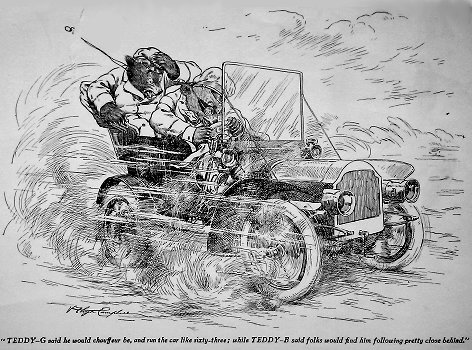
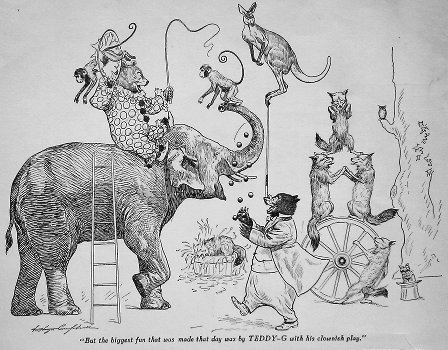
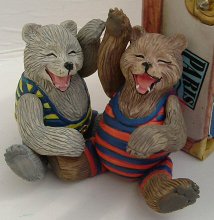 But it was extremely popular at the time, in newspapers such as the New York Times and the Chicago Daily Tribune -- so much so that as soon as there were enough weekly pages to collect into a book, Eaton did so under his real name. The books also included new full-color plates by other artists, so fine that in the late 20th century owners removed them from the books and sold them separately as art prints. Between 1906 and 1909, the illustrations were so popular that they were reprinted in miniature as postcards for sale to adults. The Roosevelt Bears were merchandised through the World War I period on stationery, children’s clothes, penknives, milk glasses, and similar items. Possibly the most attractive items were two two-inch resin dolls of Teddy-B and Teddy-G in a variety of costumes (clowns; 1910s bathing suits, etc.), designed by April Whitcomb Gustafson in a traveling trunk, manufactured by Schmidt.
But it was extremely popular at the time, in newspapers such as the New York Times and the Chicago Daily Tribune -- so much so that as soon as there were enough weekly pages to collect into a book, Eaton did so under his real name. The books also included new full-color plates by other artists, so fine that in the late 20th century owners removed them from the books and sold them separately as art prints. Between 1906 and 1909, the illustrations were so popular that they were reprinted in miniature as postcards for sale to adults. The Roosevelt Bears were merchandised through the World War I period on stationery, children’s clothes, penknives, milk glasses, and similar items. Possibly the most attractive items were two two-inch resin dolls of Teddy-B and Teddy-G in a variety of costumes (clowns; 1910s bathing suits, etc.), designed by April Whitcomb Gustafson in a traveling trunk, manufactured by Schmidt.
 There was one oddity. In 1906 and 1907, a little promotional booklet (back - inner pages: 1 - 2 - 3) showing the two bears as bakers, with text by Eaton, was produced to advertise Fleischmann’s Yeast. (There is a copyright entry dated July 20, 1907.)
There was one oddity. In 1906 and 1907, a little promotional booklet (back - inner pages: 1 - 2 - 3) showing the two bears as bakers, with text by Eaton, was produced to advertise Fleischmann’s Yeast. (There is a copyright entry dated July 20, 1907.)
Those Bears pretend to be pretty slick, But t'was Fleischmann's Yeast that did the trick.
(And how long has it been since the average American family baked its own bread?)
Strangely, it called the bears the Teddy Bears rather than the Roosevelt Bears, although they were clearly Teddy-B and Teddy-G. By 1906 “teddy bears” had become positively generic, with hundreds of people making plush dolls or cartoon drawings of them; and possibly Roosevelt didn’t mind being glorified by name in a literary work, but objected to the appearance of being used for commercial purposes while he was the president. This booklet is long since in the public domain, and CafePress has reproduced its cover on T-shirts and other merchandise.
Eaton’s rollicking doggerel carried the two friendly, well-dressed bears from the Western wilderness to the urbanized East Coast, and across the Atlantic to visit pre-World War I Europe. He wrote enough pages to collect into four annual $1.50 books between 1906 and 1909. According to Eaton's foreword:
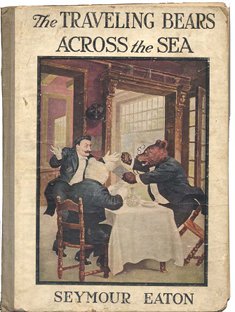
Since the name "Roosevelt" has been used in the story, it may be of public interest to know that President Roosevelt and his boys have been pleased with the story as it has appeared in serial form.
Between 1915 and the end of the World War I period, the stories were repackaged as The Traveling Bears in cut-down books under new titles, but still with the Teddy-B and Teddy-G names. After that they faded away except for the two 1921 reissues. An attempt in 1979 and 1981 to revive the series with two public-domain reprints was not successful. In 2000 and 2003 a publisher printed some of the black-&-white illustrations by R. K. Culver as a coloring book.
My parents both got some of The Roosevelt Bears books in their childhood during the 1910s. They saved them and gave them, well-worn, to me in my infancy. When I grew old enough to go to the children’s room at the public library, I asked for more Roosevelt Bears books. The librarians either didn’t know what I was talking about, or said that those were very old books and no longer in print. It was not until the rise of the Internet in the 1990s that I found the history of The Roosevelt Bears, listed there more as valuable collectibles than as once-beloved children’s books. They deserve better than to be forgotten.
Bibliography
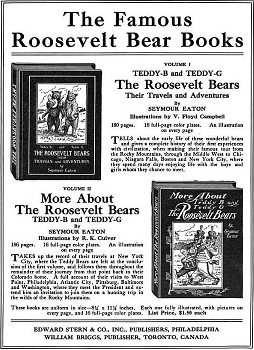 The Roosevelt Bears; Their Travels and Adventures, by Seymour Eaton (Paul Piper), illustrated by V. Floyd Campbell. Incl. 16 color plates. Philadelphia, Edward Stern & Company, September 1906, 180 pages.
The Roosevelt Bears; Their Travels and Adventures, by Seymour Eaton (Paul Piper), illustrated by V. Floyd Campbell. Incl. 16 color plates. Philadelphia, Edward Stern & Company, September 1906, 180 pages.
The Teddy Bears Baking School, by Seymour Eaton. Illustrated. Cincinnati, Fleischmann and Co., 1906/7, 12 pages. On the cover: “Compliments of the Fleischmann Co.”
The Teddy Bears: A Children’s Story, by Seymour Eaton. Illustrated
Philadelphia, Edward Stern & Company, January 1907, 16 pages.
More About Teddy B and Teddy G, the Roosevelt Bears; Being Volume Two Depicting Their Further Travels and Adventures; by Seymour Eaton (Paul Piper); illustrated by R. K. Culver.
Philadelphia, Edward Stern & Company, November 1907, 186 pages
The Roosevelt Bears Abroad; by Seymour Eaton (Paul Piper); illustrated by R. K. Culver.
Philadelphia, Edward Stern & Company, October 1908, 178 pages.
Teddy-B & Teddy-G, The Bear Detectives, by Seymour Eaton (Paul Piper), illustrated by Francis P. Wightman and William K. Sweeny. Philadelphia, Edward Stern & Company, September 1909, 178 pages.
The Traveling Bears, by Seymour Eaton. Illustrated; incl. 4 color plates.
New York, Barse & Hopkins, 1909, 184 pages + 5 pages of advertising.
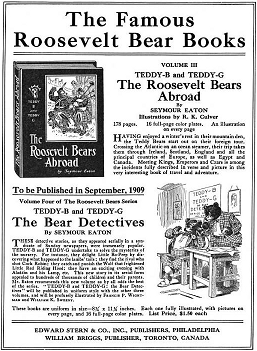
The Adventures of the Traveling Bears; Their Travels and Adventures, by Seymour Eaton (Paul Piper), illustrated by V. Floyd Campbell. New York, Barse & Hopkins, April 1915, 63 pages.
The Traveling Bears in the East & West; Their Travels and Adventures, by Seymour Eaton (Paul Piper), illustrated by V. Floyd Campbell. New York, Barse & Hopkins, April 1915, 63 pages.
The Traveling Bears in New York – Their Travels and Adventures, by Seymour Eaton (Paul Piper), illustrated by V. Floyd Campbell. New York, Barse & Hopkins, April 1915, 60 pages + 2 pages of advertising.
The Traveling Bears in Outdoor Sports; Their Travels and Adventures, by Seymour Eaton (Paul Piper), illustrated by V. Floyd Campbell. New York, Barse & Hopkins, April 1915, 60 pages + 2 pages of advertising.
The Traveling Bears at Play; Their Travels and Adventures, by Seymour Eaton (Paul Piper), illustrated by V. Floyd Campbell. New York, Barse & Hopkins, May 1916, 62 pages.
The Traveling Bears in England; Their Travels and Adventures, by Seymour Eaton (Paul Piper), illustrated by V. Floyd Campbell. New York, Barse & Hopkins, May 1916, 61 pages + 3 pages of advertising.
The Traveling Bears Across the Sea; Their Travels and Adventures, by Seymour Eaton (Paul Piper), illustrated by V. Floyd Campbell. New York, Barse & Hopkins, May 1916, 55 pages + 5 pages of advertising.
The Traveling Bears in Fairyland; Their Travels and Adventures, by Seymour Eaton (Paul Piper), illustrated by V. Floyd Campbell.
New York, Barse & Hopkins, June 1917, 62 pages.
The Traveling Bear Detectives, by Seymour Eaton (Paul Piper), illustrated by Francis P. Wightman and William K. Sweeny. 8 color plates.
New York, Barse & Hopkins, September 1921, 60 pages + 2 pages of advertising.
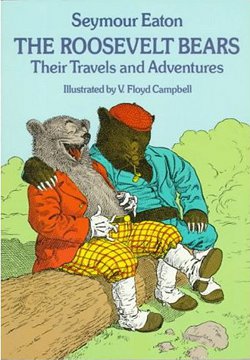
Teddy-B and Teddy-G; The Traveling Bears’ Birthday, by Seymour Eaton (Paul Piper), illustrated by Francis P. Wightman and William K. Sweeny. New York, Barse & Hopkins, September 1921, 54 pages.
The Roosevelt Bears; Their Travels and Adventures, by Seymour Eaton (Paul Piper), illustrated by V. Floyd Campbell. New York, Dover Publications, October 1979, 180 pages.
The Roosevelt Bears Go to Washington; by Seymour Eaton (Paul Piper); illustrated by R. K. Culver.
New York, Dover Publications, 1981 February 1982, 186 pages. [A reissue of More About Teddy B and Teddy G.]
The Roosevelt Bears Coloring Book, by Seymour Eaton. Illustrated by R. K. Culver.
San Anselmo, CA, Blushing Rose Publishing, LLC, 2000, 52 pages
June 2003 ed. Written by Roni Akmon and Nancy Akmon 2003-06 54 p.
Teddy Bears Traveling Adventures, compiled and edited by Nancy Akmon [text by Seymour Eaton]
San Anselmo, CA, Blushing Rose Publishing, LLC, June 2002, 48 pages. The cover features silver foil stars and type. Hardcover with a foam padded cover. Includes a die cut picture frame on the inside front cover for your child's photograph.
About the author
Fred Patten — read stories — contact (login required)a retired former librarian from North Hollywood, California, interested in general anthropomorphics
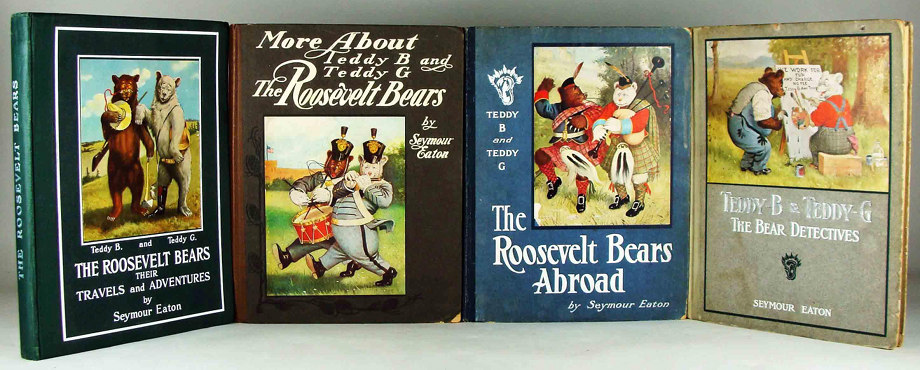
Comments
Excellent article on Seymour Eaton. But you imply the term Teddy Bears was in use before Eaton created the Roosevelt Bears - "Eaton played it both ways, saying in verse that the two bears took their names from the popular teddy bears, but using The Roosevelt Bears as his titles."
My research shows NO use of the term Teddy Bears before October 1906 - the plush bear fad exploded in 1906 with Eaton's creations, and later the references to the Roosevelt Bears, Teddy B and Teddy G, was shortened to the Teddy Bears. The October issue of Playthings magazine referred to plush jointed bears, Roosevelt Bears, and for the first time "Teddy Bears."
The term was in full use by the end of the year, and in Feb. 1907 Eaton first used the term "Teddy Bears" in his series. Although the plush jointed bears were first sold in 1903, and shown by Steiff in the 1904 St. Louis World Fair, little happened until 1906. Eaton deserves the credit for the popularity of the teddy bear with his Roosevelt Bears series.
There is also a 1907 movie called 'The Teddy Bears' by Edwin S. Porter, an acclaimed director of early cinema.
Hello, I have 3 beautiful books by Seymour Eaton, The traveling bears
- Across the Sea
-Detectives
-At Play
(Paul Piper)
Illustrated by V. Floyd Campbell
publishers, New York Barse and Hopkins
Copyright 1908 by Edward Stern com. Inc.
Hardcover
Just wondering if they are of any value
Fabulous illustrations, indeed . . . and if you want the first four books, they can be yours for 'just' $1750 (+$3.50 S&H).
IMBb says that "The 'Teddy' Bears" was released on March 2, 1907. I guess that this shows how rapidly the phrase 'teddy bears' became generic. http://www.youtube.com/watch?v=uv92LWq4xFc
Fred Patten
Charles Moose has just e-mailed me a link to an article in the Smithsonian magazine and its following argumentative commentary that claims that the whole story about how President Roosevelt spared a young bear cub during a 1902 hunt and accidentally created the teddy bear industry, was a deliberately created 1902 political whitewash. It is probably more detail about what really happened during that hunt, and about 1902 Mississippi politics, than anyone is interested in, but it seems worth linking to here. http://blogs.smithsonianmag.com/history/2012/12/the-history-of-the-teddy-bear-fr...
Fred Patten
I have five post cards that appear to be teddy Roosevelt post cards. I have searched it seems everywhere and can't find any the same. They do appear to be Seymour Eatons style . Is there a book that would show all the different Roosevelt bear kpostcards to compare mine to?
I do not know of any book, but many are shown individually on the Internet, usually in the catalogues of rare children's book dealers and on eBay.
Fred Patten
Charles Moose has just sent me this e-mail:
I'm trying to add a helpful comment to your Retrospective on Roos.Bears but cannot get signed on nor get a new password. Please add:
^^^^^^^^^^^^^^^^^^^^^^^^^^^^^^^^^^^
Many Roosevelt Bears postcards can be found with a Googlee or Bing search. E.g., using [ roosevelt bears cards images ] gives some lists and:
http://www.oldpostcards.com/roosevelt-bears-postcards.html
FYI, " On March 1, 1907, the age of the “Divided Back”, which contains a section for the address and a section for a note, was ushered in." As I recall, the first (1906) set had undivided backs, while at some point later sets had divided backs.
^^^^^^^^^^^^^^^^^
Thanks. Charles Moose
Fred Patten
can anyone tell me how many cards are in roosevelt bear collection made by stern& co? i have the other cracker jack collection 1-15 but i have no idea how many are in the other,,,,please help ty
I'm Seymour Eaton's great granddaughter, and I want to thank the July 2012 visitor who correctly credited Teddy Bears being called that only after 1906 when the Roosevelt Bears books were first published. Prior to that, they had part of a syndicated newspaper strip, but with the birth of my grandmother in 1906 (after Seymour already had four much older children) he dedicated the longer stories to her, Jean Adair Eaton. She grew up in the home he designed and built in Lansdowne, PA, and he was a publisher and entrepreneur with many other accomplishments before his death in 1916...including helping found the business and finance school at Drexel, starting the first US correspondence school and a number of marketing and advertising methods that are still used today.
The color plates to the Teddy Bear books were lost during the first World War (all scrap metal melted down) and when Dover Books reissued the books in the 1980's, reproducing them was not feasible. In flea markets, most of the books one finds have the wonderful color plates removed. It's all public domain, Seymour died suddenly at age 57 heavily invested in the next big project, and the family underwent a "reversal of fortune." His wife successfully turned their home, Ath Dara, into apartments while she remained in the main house, but the bank took it over during the Depression (although they remain in use through today). My grandmother was a wonderful character in her own right, but from her stories about the father she lost when she was 10, I have always wished to know him more than any other ancestor.
An original Teddy Roosevelt bear circa 1903. Has been discovered in Dublin, California. Hand made by Morris and Rose Michtom of Brooklyn, New York. The Michtom's made so few of these first style Teddy's. That they were lost in time. Until, Now. The Michtom's creat this first style teddy bear in honor of President Theodore Roosevelt. Made of the finest materials of the time. the Michtom's created this fist style teddy bear. To stand upright and to have this full open mouth that smiled. Including dimples to enhance the bears smile. To read more and to see amazing pictures. See website, Google + by Robert Csech. I have the world's most finest example of America's original teddy bear. Someday I hope he makes his way to a great museum.
What a great page and thread of comments. Adair Rowland- very special posting about your great grandfather. Thank you!
Within the last few years I came across some very sweet children's plates with Roosevelt Bears scenes from the stories. They are transfers and the plates are gold rimmed. They're relatively small, and can fit in my hand a bit larger than my palms. I have 5 of them. I've been unable to really to find anyone who knows much about them so thought I would post here and see if anyone is familiar with little plates like these and also if anyone is interested in them.
Brightly,
Molly
Huntington Beach, CA
Looking for price guide/catalogue of Roosevelt Bears with trunk by eaton
I have 11 of Seymour Eatons Traveling Bears books (white hard cover with lovely color illustration), and color illustration inside each. I have one duplicate title. They have clearly been read and loved by children with the bindings needing to be redone - but with all pages and covers. I'm thinking on selling them, but really don't have any idea how much the "wear and tear" affects the value.
Post new comment